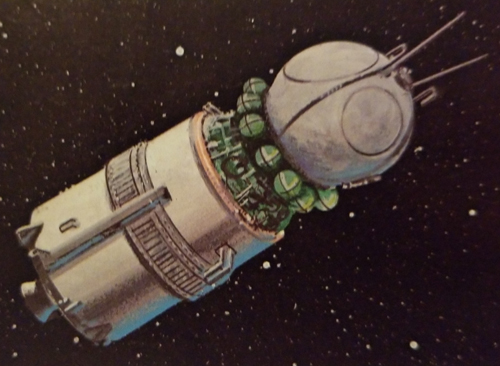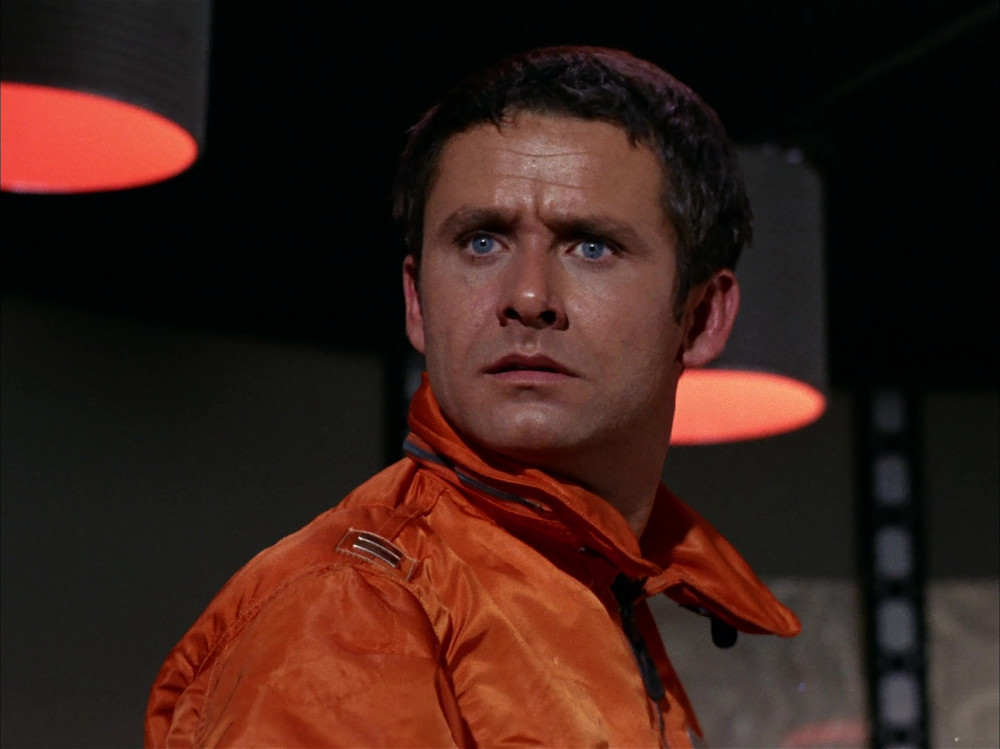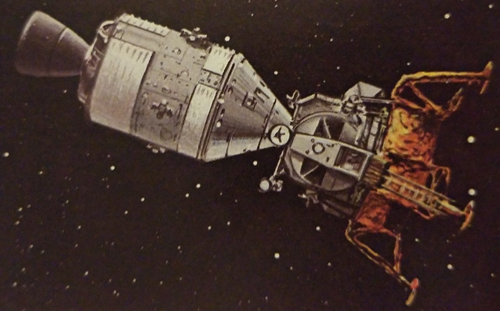Difference between revisions of "1960s (FASA)"
From Trekipedia
m |
m |
||
| (20 intermediate revisions by the same user not shown) | |||
| Line 1: | Line 1: | ||
| − | {| | + | {{ChronologyLinks|chron=FASA|year1=1950s|year2=1970s}} |
| − | | | + | {{BannerFASA|tl|100%}} |
| − | |style=" | + | <div style="text-align:center;">'''[[Reference Stardate]] -1/6001 through -1/6912'''</div> |
| − | |||
| − | |||
| − | + | * Life prolongation experiments kill the entire adult population on [[Miri's World (FASA)|Miri's World]].<ref name="TOS11"/> | |
==1961== | ==1961== | ||
| − | * RSD -1/6104.12 (12 April): [[Vostok program#Vostok_I|''Vostok'' I]] carries the first man into space. The craft orbits for one revolution of 108 minutes, and an apogee of 302.3km and a perigee of 176.3km. This historic first keeps the [[Union of Soviet Socialist Republics|USSR]] in the lead in the "space race."<ref name="SFC"/> | + | * [[lawrencium|Lawrencium]] (element 103) is discovered in the [[United States of America (FASA)|United States of America]] on [[Earth (FASA)|Earth]].<ref name="MRM"/> |
| − | * RSD -1/ | + | ===April=== |
| + | {{ImageBox2|boxwidth=250px|file=vostok_1-sfc.jpg|caption=[[Vostok program#Vostok_I|''Vostok'' I]] ([[Star Trek: Spaceflight Chronology (Book)|SFC]])}} | ||
| + | * '''RSD -1/6104.12 (12 April):''' [[Vostok program#Vostok_I|''Vostok'' I]] carries the first man into space. The craft orbits for one revolution of 108 minutes, and an apogee of 302.3km and a perigee of 176.3km. This historic first keeps the [[Union of Soviet Socialist Republics (FASA)|USSR]] in the lead in the "space race."<ref name="SFC"/> | ||
| + | * '''RSD -1/61:''' The [[United States of America (FASA)|United States]] launches [[Mercury program#Mercury_3|''Mercury'' 3]], a one-man, suborbital, 15-minute flight in preparation for its first orbital mission in 1962. The ''Mercury'' missions will last from 1961-1963.<ref name="SFC"/> | ||
==1963== | ==1963== | ||
| − | * RSD -1/ | + | * '''RSD -1/63:''' [[Vostok program#Vostok_VI|''Vostok'' VI]] carries the first woman into space, staying aloft for 45 revolutions. Maneuvering the capsule, she approaches to within 5km of the companion [[Vostok program#Vostok_V|''Vostok'' V]].<ref name="SFC"/> |
| + | |||
| + | ==1964== | ||
| + | * [[kurchatovium|Kurchatovium]] (element 104) is discovered in the [[Union of Soviet Socialist Republics (FASA)|Soviet Union]] on [[Earth (FASA)|Earth]].<ref name="MRM"/> | ||
==1965== | ==1965== | ||
| − | * RSD -1/ | + | * '''RSD -1/65:''' The first spacewalk is accomplished by [[Leonov, Aleksei|Aleksei Leonov]] aboard the [[Voskhod program#Voskhod_II|''Voskhod'' II]] spacecraft.<ref name="SFC"/> |
| − | * RSD -1/ | + | * '''RSD -1/65:''' The accelerated [[United States of America (FASA)|United States]] space program has five successful [[Gemini program|''Gemini'']] missions this year.<ref name="SFC"/> |
==1967== | ==1967== | ||
| − | * RSD -1/ | + | * '''RSD -1/67:''' The first international outer space treaty is signed, addressing the global implications of spaceflight by stressing both the peaceful exploration of space and the need to extend the rule of law into the skies. "The exploration and use of outer space, including the moon and other celestial bodies, shall be carried out for the benefit, and in the interest of, all mankind."<ref name="SFC"/> |
| − | * RSD -1/6701.26 (26 January): [[ | + | ===<span id="1967JAN">January</span>=== |
| + | {{ImageBox2|file=christopher_john-tos-21.jpg|caption=[[U.S. Air Force Ranks#Captain|Captain]] [[Christopher, John (FASA)|John Christopher]] ([[Star Trek|TOS]] [[Tomorrow is Yesterday (Episode)|21]])}} | ||
| + | * '''<span id="1967JAN26">RSD -1/6701.26 (26 January)</span>:''' [[USAF Captain|Captain]] [[Christopher, John (FASA)|John Christopher]], an Air Force interceptor pilot, reports a UFO, but it soon disappears from view. The UFO is actually the [[U.S.S. Enterprise NCC-1701 (FASA)|U.S.S. ''Enterprise'']], which has accidentally traveled back in time.<ref name="TOS21"/><ref name="FASA2004A"/> | ||
| + | {{Clear}} | ||
==1968== | ==1968== | ||
| − | * RSD -1/6803.29 (29 March): Traveling in time, the crew of the [[U.S.S. Enterprise NCC-1701|U.S.S. ''Enterprise'']] encounters Supervisor 194, [[Seven, Gary|Gary Seven]], on an assignment to prevent 20th-century [[Earth]] from destroying itself in nuclear war.<ref name=" | + | * '''RSD -1/68:''' In an historic first, the 3-man crew of [[Apollo program#Apollo_8|''Apollo'' 8]] journeys around the [[Luna (FASA)|moon]], observing and photographing the natural satellite and viewing "Earthrise."<ref name="SFC"/> |
| − | + | ===March=== | |
| + | * '''RSD -1/6803.29 (29 March):''' Traveling in time, the crew of the [[U.S.S. Enterprise NCC-1701 (FASA)|U.S.S. ''Enterprise'']] encounters Supervisor 194, [[Seven, Gary (FASA)|Gary Seven]], on an assignment to prevent 20th-century [[Earth (FASA)|Earth]] from destroying itself in nuclear war.<ref name="TOS55"/><ref name="FASA2004A"/> | ||
==1969== | ==1969== | ||
| − | * RSD -1/6807.20 (20 July): The age-old dream of landing a man on the [[ | + | ===<span id="1969JUL">July</span>=== |
| − | + | {{ImageBox2|boxwidth=250px|file=apollo_11-sfc.jpg|caption=[[Apollo program#Apollo 11|''Apollo'' 11]] ([[Star Trek: Spaceflight Chronology (Book)|SFC]])}} | |
| − | + | * '''RSD -1/6807.20 (20 July):''' The age-old dream of landing a man on the [[Luna (FASA)|moon]] is realized when the [[Apollo program#Apollo_11|''Apollo'' 11]] [[Apollo program#LEM|Lunar Module]] lands in the Sea of Tranquility. Astronauts [[Armstrong, Neil|Neil Armstrong]] and [[Aldrin, Edwin|Edwin "Buzz" Aldrin]] remain on the surface for 21 hours 36 minutes.<ref name="SFC"/><ref name="FASA2004A"/> | |
| − | |||
| − | |||
| − | |||
| − | |||
| − | {| | + | {{ChronologyLinks|chron=FASA|year1=1950s|year2=1970s}} |
| − | + | {{References}} | |
| − | + | <references> | |
| − | + | <ref name="TOS11">{{RefTOS11}}</ref> | |
| − | <ref name="SFC"> | + | <ref name="TOS21">{{RefTOS21}}</ref> |
| − | <ref name="FASA2004A"> | + | <ref name="TOS55">{{RefTOS55}}</ref> |
| + | <ref name="MRM">{{RefMRM}}</ref> | ||
| + | <ref name="SFC">{{RefSFC}}</ref> | ||
| + | <ref name="FASA2004A">{{RefFASA2004A}}</ref> | ||
</references> | </references> | ||
| − | + | [[Category:Chronology]] | |
| + | [[Category:FASA Timeline]] | ||
Latest revision as of 23:53, 25 February 2023
Reference Stardate -1/6001 through -1/6912
- Life prolongation experiments kill the entire adult population on Miri's World.[1]
1961
- Lawrencium (element 103) is discovered in the United States of America on Earth.[2]
April
- RSD -1/6104.12 (12 April): Vostok I carries the first man into space. The craft orbits for one revolution of 108 minutes, and an apogee of 302.3km and a perigee of 176.3km. This historic first keeps the USSR in the lead in the "space race."[3]
- RSD -1/61: The United States launches Mercury 3, a one-man, suborbital, 15-minute flight in preparation for its first orbital mission in 1962. The Mercury missions will last from 1961-1963.[3]
1963
- RSD -1/63: Vostok VI carries the first woman into space, staying aloft for 45 revolutions. Maneuvering the capsule, she approaches to within 5km of the companion Vostok V.[3]
1964
- Kurchatovium (element 104) is discovered in the Soviet Union on Earth.[2]
1965
- RSD -1/65: The first spacewalk is accomplished by Aleksei Leonov aboard the Voskhod II spacecraft.[3]
- RSD -1/65: The accelerated United States space program has five successful Gemini missions this year.[3]
1967
- RSD -1/67: The first international outer space treaty is signed, addressing the global implications of spaceflight by stressing both the peaceful exploration of space and the need to extend the rule of law into the skies. "The exploration and use of outer space, including the moon and other celestial bodies, shall be carried out for the benefit, and in the interest of, all mankind."[3]
January
- RSD -1/6701.26 (26 January): Captain John Christopher, an Air Force interceptor pilot, reports a UFO, but it soon disappears from view. The UFO is actually the U.S.S. Enterprise, which has accidentally traveled back in time.[4][5]
1968
- RSD -1/68: In an historic first, the 3-man crew of Apollo 8 journeys around the moon, observing and photographing the natural satellite and viewing "Earthrise."[3]
March
- RSD -1/6803.29 (29 March): Traveling in time, the crew of the U.S.S. Enterprise encounters Supervisor 194, Gary Seven, on an assignment to prevent 20th-century Earth from destroying itself in nuclear war.[6][5]
1969
July
- RSD -1/6807.20 (20 July): The age-old dream of landing a man on the moon is realized when the Apollo 11 Lunar Module lands in the Sea of Tranquility. Astronauts Neil Armstrong and Edwin "Buzz" Aldrin remain on the surface for 21 hours 36 minutes.[3][5]
Notes and References
- ↑ Roddenberry, Gene (Executive Producer). "Dagger of the Mind". Star Trek, season 1, episode 9 (Production number 11). Directed by Vincent McEveety. Written by S. Bar-David. Desilu Productions. 3 November 1966.
- ↑ 2.0 2.1 Palestine, Eileen and Geoffrey Mandel (Editors). Star Fleet Medical Reference Manual. Star Trek. Book. Originally published by Star Fleet Productions, Inc.. Ballantine Books. 1977.
- ↑ 3.0 3.1 3.2 3.3 3.4 3.5 3.6 3.7 Goldstein, Stan et al (Authors). Spaceflight Chronology. Star Trek. Book. Wallaby Books. 1980.
- ↑ Roddenberry, Gene (Executive Producer). "Tomorrow is Yesterday." Star Trek, Season 1, Episode 19 (Production 21). Directed by Michael O'Herlihy. Written by D.C. Fontana. Desilu Productions, 26 January 1967.
- ↑ 5.0 5.1 5.2 Wheeler, Wm. John et al (Authors). Cadet's Orientation Sourcebook. Star Trek: The Role Playing Game. Book 2004A, Second Edition. Cover art by Rowena. Graphics and layout by Dana Knutson and Jordan Weisman. FASA Corporation. 1983.
- ↑ Roddenberry, Gene (Executive Producer/Story). "Assignment: Earth." Star Trek, Season 2, Episode 26. Directed by Marc Daniels. Story by Gene Roddenberry & Art Wallace. Teleplay by Art Wallace. Desilu Productions, 29 March 1968.


